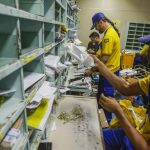The Ministries of Agriculture and Commerce, and the National Planning Department, began dialogues with the dairy and rice sectors to find solutions to the current situation and to the structural problems that each one faces.
(See: Petro government’s land management has not achieved the proposed goals)
The following participated in the articulation table: producers, industrialists and union representativesamong others, with the aim of drawing up a roadmap to address the situations that these sectors are experiencing: the dairy sector is related to the drop in prices, while in the rice sector it is about the “need” for an incentive for storage.
In dairy activity, It was identified that there are high levels of powdered milk inventories, a slowdown in consumption, and limitations in the collection of surpluses by the industry.high informality and the effects on the market due to the Free Trade Agreements.
(Read more: Brazilian productivity displaces Colombian livestock exports)
“To face these challenges, the work proposal aims to promote a strategy for the internationalization of the dairy sector, activate the routes for the definition of trade defense measures that guarantee fair and balanced trade, and seek access to international markets.“the Government said.
The Minister of Commerce, Industry and Tourism, Luis Carlos Reyes
Courtesy
Now, In the midst of the discussions, there was talk of generating public purchasing mechanisms with regional authorities that include dairy products.reinforce the consumption campaign under a nutritional approach that is essential in the Colombian diet and define the implementation of a formalization route aimed at producers, intermediaries, processors and marketers.
(Read also: ADR to finance projects to replace illicit coca plantations with food)
At the time, the president of Asoleche, Ana María Gómez, told Portafolio in an interview that the last few years have been challenging for the industry, taking into account that In 2022 alone, dairy consumption fell by 9% and in 2023 it fell by 6%.
In this regard, the Minister of Agriculture and Rural Development, Martha Carvajalino, highlighted that the ideas reflect that the entire chain has a common commitment, and it is up to the Government to study these measures.
(Read: Supersociedades assures that there is no irregularity with Monómeros)
“We will review everything. There are some regulatory measures whose modification could help to ward off the current situation, but there are structural issues that merit in-depth discussions.“, said the head of the portfolio.

The president of Asoleche, Ana Maria Gomez
Courtesy
For his part, the Minister of Commerce, Industry and Tourism, Luis Carlos Reyes, referred to the Export Promotion table, to study access to international markets and trade defence measures.
(Read also: Bioeconomy, option to recover industrialization in the country)
“In order to identify markets with high potential for Colombian dairy products, as well as to resolve issues of sanitary admissibility, special attention will be paid to ensuring compliance with the requirements demanded by Colombia’s trading partners.”Reyes explained.
Even the Superintendent of Industry and Commerce, Cielo Rusinque, stated that from that organization, “The actors in the dairy chain have all the support and guidance for the registration of new designations of origin, an example of this is the process that is currently being carried out for the registration of the designation of Queso Costeño, which would be added to the existing registrations of Queso Paipa and Queso del Caquetá.”.
(See more: Using AI will help generate profitability and productivity in agriculture)

Martha Carvajalino, new Minister of Agriculture and Rural Development.
Private file
Rice situation
For its part, through a letter addressed to the Minister of Agriculture, Martha Carvajalino, the rice growers’ union warned in recent days that Producers in the sector have been experiencing a decrease in the price of Paddy rice..
(Read: Rice farmers and the Government have approached each other to discuss the storage incentive)
According to them, concern is growing given that this type of rice is the one that pays for the milling industry, a situation that is at risk since the largest harvest of the second half of the year has begun, which will last until mid-October. In addition, Fedearroz has insisted on the need to implement incentives for grain storage.
In this regard, from the dialogue tables Alexander López Maya, Director of Planning, explained that “We are committed to economic recovery and to continuing to promote the great objective of President Gustavo Petro to give the country a comprehensive Agrarian Reform, which involves all the actors in a great National Agreement.”.
(See more: Government would recognize rural areas within forest reserves: what does it mean?)

Rafael Hernandez, general manager of Fedearroz
Courtesy
The conversation with the rice farmers revealed the panorama of the chain in the country, challenges and challenges in the short, medium and long term with with an eye on establishing itself as a fundamental product of the national economy.
(See also: ‘Our America is a power to confront the climate crisis’: Ministry of Agriculture)
For Minister Carvajalino, “There is a commitment to the competitiveness of the sector, but there is a call that we must make, and that is that the private sector must be clear about where the chain is going. (…) We must advance in competitiveness with agreements between producers, industrialists and marketers to strengthen initiatives that allow productive chains.”.
In turn, Minister Reyes Hernández invited producers and industry representatives to advance joint work to analyze and, to the extent possible, review the policies and instruments that have impacted the industry and affect food sovereignty.
(Read: ‘Being against agrarian reform is going against the balance of life’: Petro)
“It is necessary to put forward proposals and alternatives that allow the recovery of the sector, the preservation of food sovereignty and the promotion of exports. This is a Government with a different vision“, declared the Minister of Trade, Industry and Tourism.
PORTFOLIO

















